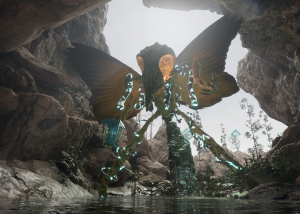SXSW 2019 featured plenty of immersive work to sample, whether interactive or VR or installation. Most of the exciting work is neither nonfiction nor storytelling. It’s experiential, and only sometimes interactive.
Experience, experience, experience.
I watched non-interactive VR that created a satisfying experience, like the Maui Ocean Center’s opportunity to swim with humpback whales. In the museum, it’s a headset-free, planetarium-like experience. Re-Animated, from the Erratic Animist art

The VR experience Re-Animated brings you into a rainforest with memories of an extinct bird.
collective, is a captivating meditation n a now-extinct bird. The audio diaries of the matter-of-fact scientist who charted its demise accompany extravagant and disturbing imagery superimposed on a recreation of Hawai’ian rainforest. They both made me feel that the awkward headset experience was worth it.
Two works demonstrated intriguing play with music, interactivity and XR. In Tonandi, a Magic Leap project with the Icelandic band Sigur Ros, you co-create a musical experience by touching fantastical AR plants that trigger different musical moments. “We would like you to think that of the experience as if you had an aquarium of your favorite musician,” said co-director Michael Tucker. Magic Leap has done other work combining AR and music; its headset is human-sized and comfortable.
In –22.7 C, you travel along with French musician Molecule to northern Greenland and inside his own imagination, while also co-designing the auditory experience. I found Molecule’s imagination to be less interesting than the Greenland landscape, but the experience was fascinating.
Brillhart on VR.

Jessica Brillhart says tech is the tool, not the goal.
Jessica Brillhart, the doyenne of VR filmmaking, was back at SXSW after the launch of her new company VRAI. She showed off the latest examples of her immersive work, including spatial audio (on Traverse, available in the app store,). Spatial audio lets a viewer walk around a sound experience, for instance deciding to be closer to the violins than the oboes, or to check out the bass.
She had some core observations:
You don’t need to be in charge in the same way you are in linear storytelling. In immersive media, “our cameras are people, with their own autonomy.” Perhaps you can extend their perception of reality. Give visitors an experiential flow. It’s like music, like a dance.
In this very young and emergent form, it’s not storytelling,—it’s stories telling. After all, the camera is now in the head of the person experiencing your work. The more stories the better, in fact.
There is no one truth to tell. Success is when “they get the truth of that experience,” whatever the person’s experience is.
Game design, she said, is the heart and soul of the creative process in XR.
Finally, Brillhart was not the only speaker at SXSW to remind the audience that tech is the tool, not the goal.
